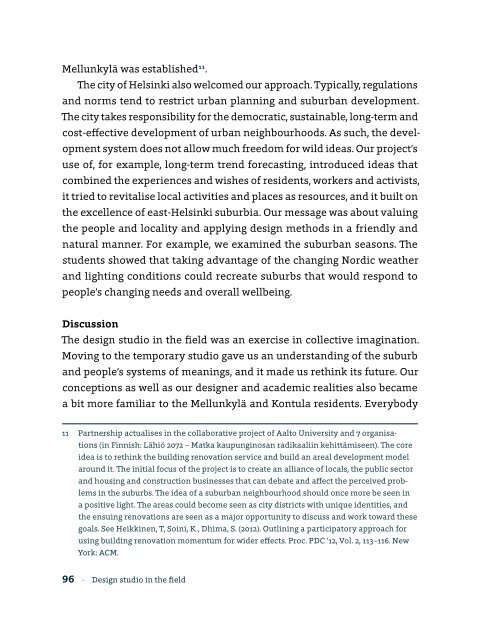Designing for wellbeing
Designing for wellbeing
Designing for wellbeing
You also want an ePaper? Increase the reach of your titles
YUMPU automatically turns print PDFs into web optimized ePapers that Google loves.
Mellunkylä was established 11 .<br />
The city of Helsinki also welcomed our approach. Typically, regulations<br />
and norms tend to restrict urban planning and suburban development.<br />
The city takes responsibility <strong>for</strong> the democratic, sustainable, long-term and<br />
cost-effective development of urban neighbourhoods. As such, the development<br />
system does not allow much freedom <strong>for</strong> wild ideas. Our project’s<br />
use of, <strong>for</strong> example, long-term trend <strong>for</strong>ecasting, introduced ideas that<br />
combined the experiences and wishes of residents, workers and activists,<br />
it tried to revitalise local activities and places as resources, and it built on<br />
the excellence of east-Helsinki suburbia. Our message was about valuing<br />
the people and locality and applying design methods in a friendly and<br />
natural manner. For example, we examined the suburban seasons. The<br />
students showed that taking advantage of the changing Nordic weather<br />
and lighting conditions could recreate suburbs that would respond to<br />
people’s changing needs and overall <strong>wellbeing</strong>.<br />
Discussion<br />
The design studio in the field was an exercise in collective imagination.<br />
Moving to the temporary studio gave us an understanding of the suburb<br />
and people’s systems of meanings, and it made us rethink its future. Our<br />
conceptions as well as our designer and academic realities also became<br />
a bit more familiar to the Mellunkylä and Kontula residents. Everybody<br />
11 Partnership actualises in the collaborative project of Aalto University and 7 organisations<br />
(in Finnish: Lähiö 2072 – Matka kaupunginosan radikaaliin kehittämiseen). The core<br />
idea is to rethink the building renovation service and build an areal development model<br />
around it. The initial focus of the project is to create an alliance of locals, the public sector<br />
and housing and construction businesses that can debate and affect the perceived problems<br />
in the suburbs. The idea of a suburban neighbourhood should once more be seen in<br />
a positive light. The areas could become seen as city districts with unique identities, and<br />
the ensuing renovations are seen as a major opportunity to discuss and work toward these<br />
goals. See Heikkinen, T, Soini, K., Dhima, S. (2012). Outlining a participatory approach <strong>for</strong><br />
using building renovation momentum <strong>for</strong> wider effects. Proc. PDC ’12, Vol. 2, 113–116. New<br />
York: ACM.<br />
96 · Design studio in the field
















